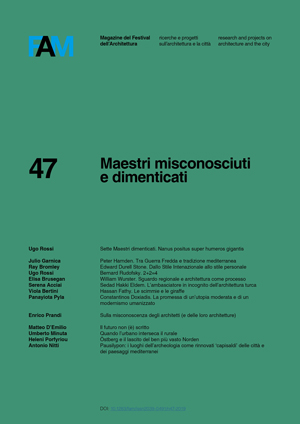Constantinos A. Doxiadis e la sua Entopia: La promessa di un’utopia moderata e di un modernismo umanizzato
Pubblicato 2019-04-01
Parole chiave
- Doxiadis,
- Entopia,
- Utopia
Come citare
Abstract
Questo saggio riassume la storia e la politica della visione urbana di Constantinos Doxiadis, fiorita a livello internazionale dopo la seconda guerra mondiale, che reinventava gli architetti pianificatori come scienziati, tecnocrati e esperti di sviluppo, rinegoziando il razionalismo e l’individualismo del modernismo. Concentrandosi su “entopia”, la visione di Doxiadis di un tessuto urbano ideale, il saggio espone le ambizioni sociali e formali della teoria Echistica di Doxiadis e analizza gli allineamenti del suo Doxiadis Associates con i nuovi discorsi postbellici sullo sviluppo socioeconomico internazionale e sulla gestione ambientale. Entopia fornisce la base per una riflessione critica sulla versione modernista di Doxiadis, la sua enfasi sulla multidisciplinarietà e le sue concezioni di “armonia” globale, tutte in linea con le attuali situazioni socio-politiche, urbane e ambientali.
Riferimenti bibliografici
- “Busy Remodeler of the World” (1966) – Life. October 7.
- DAECHSEL M. (2015) – Islamabad and the politics of International development in Pakistan. Cambridge University Press, Cambridge.
- DOXIADIS C. (1945) – “To Architects and All Who Are Interested in the Physical Environment at the United Nations”. Athens 12 October.
- DOXIADIS C. (1963) – Architecture in Transition. Oxford, London.
- DOXIADIS C. (1966) – Between Dystopia and Utopia. Trinity College Press, Hartford.
- DOXIADIS C. (1968a) – Ekistics: An Introduction to the Science of Human Settlements, Oxford University Press, New York.
- DOXIADIS C. (1968b) – “Energy and Human Settlements”, Lecture delivered at the Edison Electric Institute, New York, Jan 31.
- DOXIADIS C. (1974) – “Entopia”; a short description that accompanies a rendering of entopia printed on DA’s greeting cards.
- DOXIADIS C., DOUGLASS T. B. (1965) – “The New World of Urban Man”. United Church Press, Philadelphia-Boston.
- GIEDION S. (1941) – Space, Time and Architecture. Harvard University Press, Cambridge. 2-28.
- KATSIKIS N. (2013) – Two approaches to “World Management”: R. B. Fuller and C. A. Doxiadis. In: N. Brenner (ed.). Implosions/Explosions: Towards a study of Planetary Urbanization. Jovis verlag, Berlin. 480.
- Martin R. (1977) – “Crystal Balls”, Any 17.
- MCLEOD M. (1983) – “Architecture or Revolution; Taylorism, Technocracy and Social Change.” Art Journal, Summer 1983. 132-147.
- MUZAFFAR I. (2012) – “Boundary Games: Ecochard, Doxiadis, and the Refugee Housing Projects under Military Rule in Pakistan, 1953–1959.” In: Governing by design: architecture, economy and politics in the twentieth century. University of Pittsburgh Press, Pittsburgh. 389-452.
- ΦΙΛΙΠΠΊΔΗΣ, Δ. (2015) – Κωνσταντίνος Α. Δοξιάδης (1913 – 1975): αναφορά στον Ιππόδαμο. Αθήνα: Μέλισσα.
- PHOKAIDES P. (2013) – De-tropicalizing Africa: architecture, planning and climate in the 1950s and the 1960s. Docomomo Journal, no.48, pp. 76-82;
- PHOKAIDES P. (2018) – “Rural networks and planned communities: Doxiadis Associates’ plans for rural settlements in post-independence Zambia”, The Journal of Architecture.
- PROVOOST M. (2015) – Exporting new towns: the welfare city in Africa. In: M. Swenarton, T. Avermaete, D. van den Heuvel (eds) Architecture and the Welfare State. Routledge New York. 277-298;
- PYLA P. (2007) – “Hassan Fathy revisited: postwar discourses on science, development, and vernacular architecture.” Journal of Architectural Education, 3. 28-39.
- PYLA P. (2008) – “Baghdad’s urban restructuring, 1958”. In S. Isenstadt, K. Rizvi, Modernism and the Middle East: Architecture and Politics in the Twentieth Century. University of Washington Press, Washington.
- PYLA P. (2009) – “Planetary Home and Garden: Ekistics and Environmental - Developmental Politics.” Grey Room 36. 6-35.
- PYLA P. (2013) – “Architects as development experts: model communities in Iraq and Syria.” In: P. Pyla (ed.) Landscapes of development: the impact of modernization discourses on the physical environment of the Eastern Mediterranean. Harvard University, Cambridge.167-189.
- PYLA P. (2013b) – “Architects as development experts”. In Landscapes of Development: The Impact of Modernization Discourses on the Physical Environment of the Eastern Mediterranean, edited by P. Pyla. Harvard University, Cambridge. 166-189.
- PYLA P. (2013c) – “Gossip on the Doxiadis ‘Gossip Square’: unpacking the histories of an unglamorous public space.” Architectural Histories, 1 (1). [online] <http://dx.doi.org/10.5334/ah.bb>.
- PYLA P. (2015) – “Delos Symposia: Leaving Earth to save it.” In G. Borasi (ed.), The Other Architect, Center for Canadian Architecture and Spector Books. 270-273.
- Pyla P., Papadopoulos G. (2014) – Doxiadis’s one big Pan-Africa. In: B. Albrecht, (ed.), Africa: Big Change, Big Chance. Editrice Compositori, Bologna. 67-70.
- RAND C. (1963) – “The Ekistic World”.The New Yorker May 11. 49-87.
- Richards S. (2012) – “Halfway Between the Electron and the Universe: Doxiadis and the Delos Symposia.” Ιn: G. Adler, T. Brittain-Catlin and G. Fontana-Giusti (eds.) Scale: Imagination, Perception and Practice in Architecture. Routledge. London. 170-181.
- SHOSHKES E. (2013) – Jaqueline Tyrwhitt: a Transnational Life in Urban Planning and Design. Surrey. Ashgate Pub. Limited. Farnham.
- WARD B. (l966) – “The decade of Development; A study in Frustration” in Two Views On Aid To Developing Countries. Institute of Economic Affairs, London. 14.
- WIGLEY M. (2001) – “Network fever.” Grey Room, 4, (summer) 2001. 82-122.

